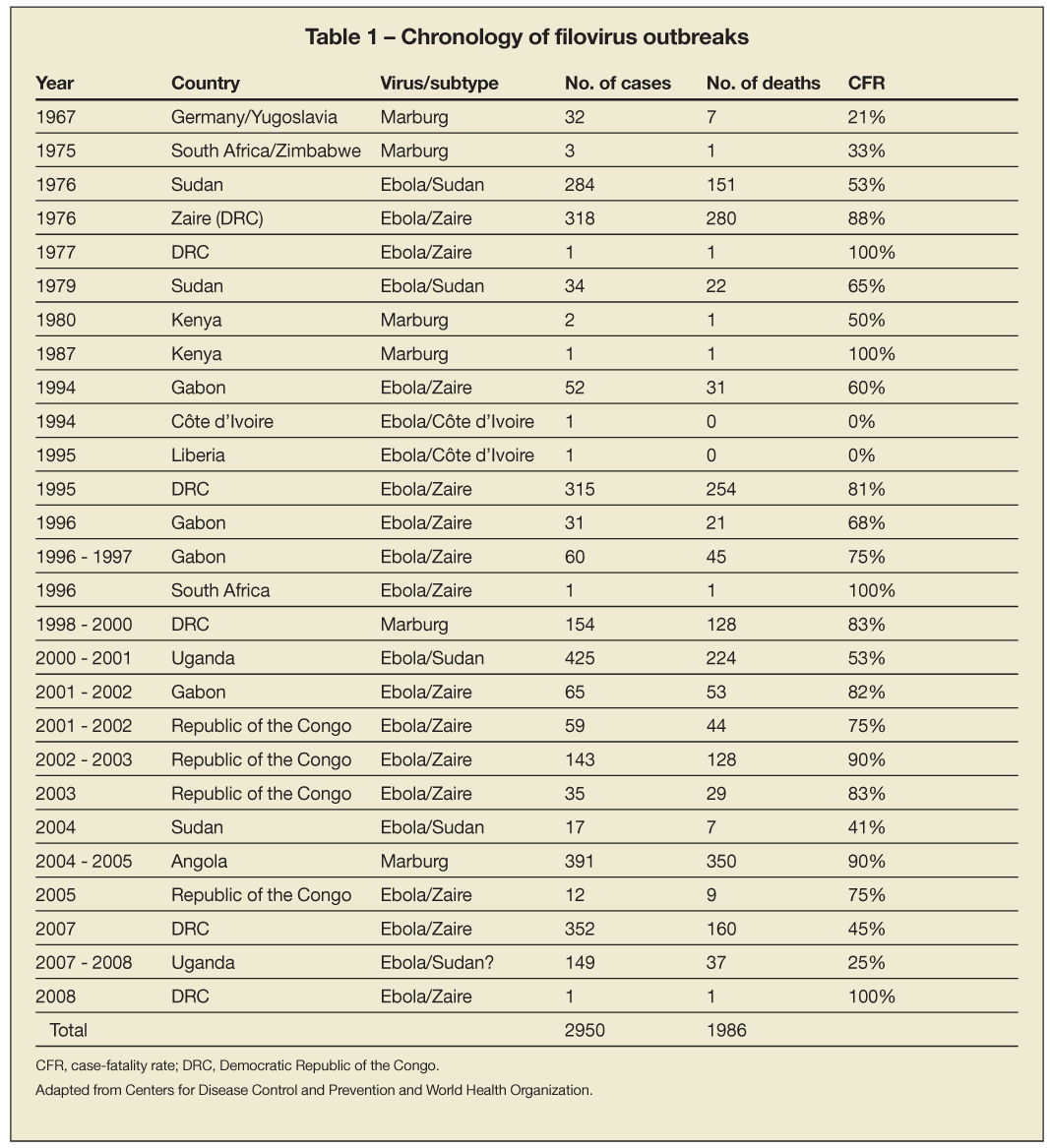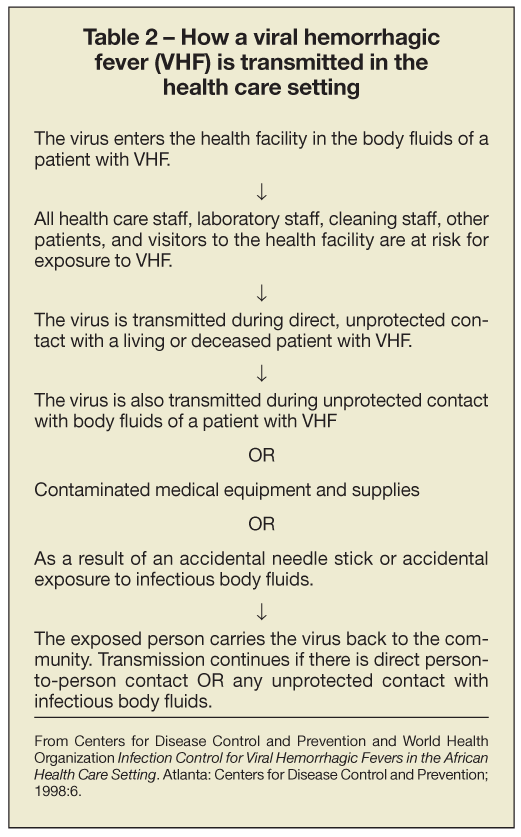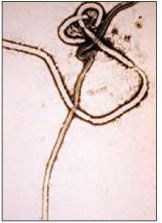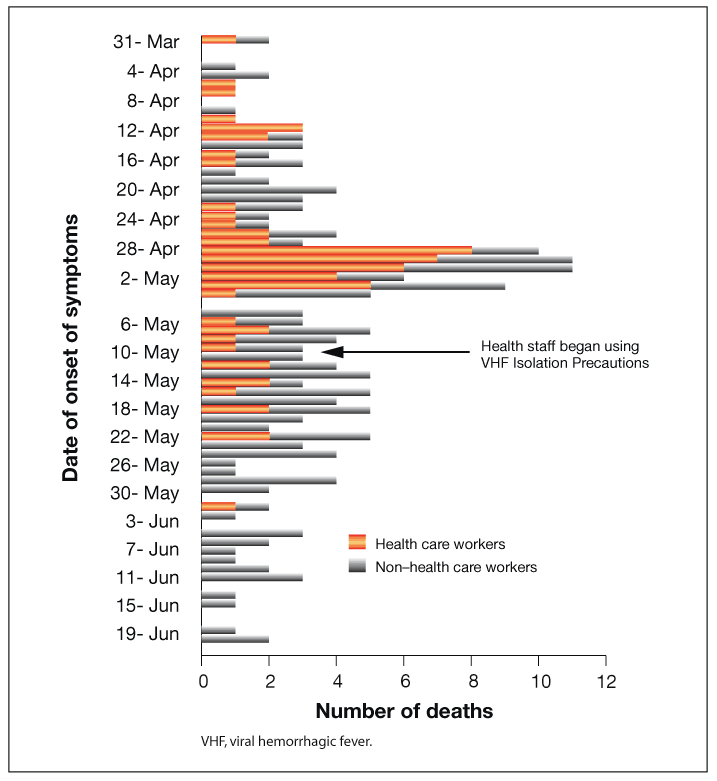Ebola Hemorrhagic Fever and Marburg Hemorrhagic Fever
Ebola virus and Marburg virus are responsible for Ebola hemorrhagic fever (EHF) and Marburg hemorrhagic fever (MHF), respectively.
Key words: Ebola virus, Ebola hemorrhagic fever, Marburg virus, Marburg hemorrhagic fever, Filovirus
Ebola virus and Marburg virus are responsible for Ebola hemorrhagic fever (EHF) and Marburg hemorrhagic fever (MHF), respectively. These infections, while uncommon, garner tremendous media

coverage when outbreaks occur. The causative organisms are found in tropical Africa and the Philippines. They belong to the Filoviridae family. Clinical presentations of the viral infections they cause share many common characteristics. At least 6 Marburg virus outbreaks and 21 Ebola virus outbreaks have been documented to date (Table 1). More outbreaks have probably occurred in remote areas before good documentation efforts could be made. The infections can be difficult to study because outbreaks are sporadic and typically occur in high-conflict areas.
There is no cure or specific treatment for infections caused by either Ebola virus or Marburg virus, and the case-fatality rate for Ebola virus infection in particular is high. Supportive care is the only therapy currently available, and strict infection control measures are essential to preventing the spread of the virus during an outbreak.
Epidemiology and transmission
Both viruses tend to be-but are not always-geographically restricted. Infectious outbreaks are sporadic and unpredictable, primarily occurring in the tropics and usually among rural, indigenous workers. Ebola virus outbreaks also appear to be associated with the end of rainy seasons that have sharply drier conditions than what is common.1
Humans are not the natural reservoir for either virus. Nonhuman primates also become infected, and because they seem to suffer the same fate as infected humans, they likely are not reservoirs either. Although intensive efforts to find the natural reservoirs of Ebola and Marburg viruses have been made, little definitive success has been achieved in this endeavor. No reservoir has been identified for Ebola virus to date despite the fact that 4700 mammals have been tested, whereas bats and possibly rodents have been found to harbor Marburg virus.2-5 Animal-to-human transmission of the virus also has been documented by contact with both slaughtered and live animals, including infected chimpanzees, gorillas, and forest antelope. The only outbreak of Ebola virus infe

ction in the United States occurred from the handling of cynomolgus monkeys.
Human-to-human transmission from contact with body fluids, including blood, urine, feces, saliva, and semen, has been clearly documented.6 No aerosol transmission has been documented. Patients are most infectious during the severe phase of illness when hemorrhagic manifestations occur. Transmission does not occur during the incubation period.
Ebola virus has been notably spread at burial ceremonies in Africa where mourners have direct contact with the body of the deceased. Because of work-related exposure to contaminated syringes and needles, laboratory workers are at particularly high risk for infection with Ebola and Marburg viruses as well.7 Indeed, because all body fluids from patients with EHF and MHF are infectious, the risk to health care providers is high. During the 1995 EHF outbreak in Kikwit, Zaire (now the Democratic Republic of the Congo), one-fourth of the cases were in health care workers.8 It is now established that failure to use correct infection control precautions and the use of inadequate barrier nursing procedures were the primary causes (Table 2).
The organism and pathophysiology
Both Ebola virus (Figure 1) and Marburg virus are nonsegmented, negative-strand RNA viruses that resemble rhabdoviruses and paramyxoviruses in genome organization and replication mechanisms. Ebola virus has 4 distinct subtypes: Ebola Zaire, Ebola Sudan, Ebola Cte d’Ivoire, and Ebola Reston. The first 3 are found in tropical Africa and cause disease in humans; the fourth is endemic to the Philippines and causes asymptomatic illness. Marburg virus has only a single type. Because differences between the Ebola virus subtypes and Marburg virus are genetically distinct, immunological cross-protection does not occur.

Figure 1 –Filoviruses have a unique appearance under electron microscopy. Both Ebola and Marburg viruses resemble one another, appearing as elongated threads that typically have a coil or curl. (Image courtesy of Centers for Disease Control and Prevention.)
Filoviruses first enter macrophages and dendritic cells and replicate. They then spread to local lymphatic structures. Viremia, with systemic spread and a predilection for the lymphoid tissue in the liver, spleen, and thymus, ensues. The pathological condition arises from both the virus and the host response and is both antibody- and cell-mediated.
The Ebola P35 protein has been found to specifically suppress RNA silencing.9 Cytokines and other mediators of shock and inflammation induce vascular damage in the small vessels, resulting in increased permeability in addition to cellular damage. A coagulopathy arises from decreased coagulation factors and platelets.
Clinical features
The initial signs and symptoms of EHF and MHF appear abruptly and are typically nonspecific. A bleeding diathesis is the most notable feature of infection, although hemorrhage may be slight and blood loss is not a cause of death. Multiorgan system failures occur: poor prognoses are associated with shock, encephalopathy, seizures, and extensive hemorrhage.
EHF has an incubation period that ranges from 2 to 21 days, usually 5 to 7 days. An abrupt onset of fever, chills, headache, myalgia, sore throat, intense weakness, nausea, vomiting and diarrhea, chest pain, and delirium occurs. In addition, a relative bradycardia, sore throat or cough, a sensation of a knot in the throat, and a nonpruritic maculopapular rash on the torso or buttocks may develop. These symptoms lead to progressive prostration, stupor, bleeding, hypotension, hepatic failure, acute renal failure, and disseminated intravascular coagulopathy.10
The presentation of MHF is nearly identical to that of EHF, with an incubation period of 3 to 10 days. Abrupt-onset high fever, severe headache, malaise, and myalgia occur followed by progressive and rapid debilitation on the first day of symptom onset. By the third day, severe watery diarrhea, abdominal pain and cramping, nausea, and vomiting occur. Patients appear “ghostlike” with drawn features, deep-set eyes, expressionless faces, and extreme lethargy that can resemble cholera. In the 1967 European outbreak, a nonpruritic rash was noted between days 2 and 7.
Between days 3 and 7, the infamous severe widespread hemorrhagic manifestations-petechia ecchymoses, conjunctival hemorrhage, gingival bleeding, bleeding from an injection site, and GI bleeding (including hematemesis)-manifest in 20% of patients.10 CNS dysfunction appears as confusion, irritability, and aggression. By day 8 or 9, death usually occurs and typically is preceded by severe blood loss and shock. The mortality rate of Ebola virus infection is 72%, that of Marburg virus infection is 23%.11
Diagnosis
Clinical suspicion is the most important element in making the diagnosis, particularly outside of Africa. It is useful-perhaps essential-to develop a case definition, particularly if evidence of an outbreak becomes apparent.
Standard laboratory findings are supportive. Confirmatory identification of the pathogen requires isolation of the virus at a Biosafety Level 4 facility. Isolating the virus is essential, but a time element is involved; it may take 5 to 7 days to identify the pathogen.
Viral polymerase chain reaction (PCR) antigen testing may be the fastest and most reliable tool available, but it has limitations, although that is changing.12 PCR testing can identify a virus in 1 day. Serology testing also is very useful, particularly because Marburg and Ebola viruses do not cross-react antigenically. Enzyme-linked immunosorbent assay testing also is reliable,13 although an IgM level may not be seen until day 5 or later, and a 4-fold rise in IgG level may not be seen until days 7 to 14. Standard laboratory testing may reveal elevated liver enzyme levels, with an elevation in the level of aspartate aminotransferase greater than that of alanine aminotransferase; decreased plasma total protein level; leukopenia; and thrombocytopenia.
Besides the standard complete blood cell count, it is essential that additional tests be performed, such as international normalized ratio, prothrombin time, and partial thromboplastin time. Malaria smears and blood cultures are vital when testing acutely ill patients who have been in tropical regions.
Treatment, prevention, and control
No specific treatment for infection with filoviruses is available. Experimental studies in animals using hyperimmune sera have failed to show a protective effect. Treatment is based on intensive supportive care and management of blood pressure and coagulopathy.14,15 Personal protective measures are the main defense in areas where Ebola is endemic. No vaccine is available, although several vaccine candidates are under evaluation.
Containment is an essential tool in controlling the spread of filoviruses. Patients with suspected infection must be isolated from other patients, and strict barrier nursing techniques must be instituted. In the Kikwit outbreak in 1995, transmission was markedly reduced after barrier nursing practices were implemented (Figure 2).

Figure 2 –The number of infected health care workers declined after barrier nursing practices were begun during the Ebola hemorrhagic fever outbreak at Kikwit, Democratic Republic of the Congo, in 1995. One case resulted from inappropriate use of barrier nursing practices. (From Centers for Disease Control and Prevention and World Health Organization. Infection Control for Viral Hemorrhagic Fevers in the African Health Care Setting. Atlanta: Centers for Disease Control and Prevention; 1998:3.)
Because of dramatization by the media, the level of fear and panic caused by reports of filovirus outbreaks-even within the medical community-is disproportionate to the actual impact that the outbreaks have. It is essential that health care providers and medical personnel be briefed about the disease and routes of transmission and have their fears allayed. They need to be reminded that hospital training about avoidance of nosocomial spread of infections is fundamental and not only relegated to filovirus infection outbreaks.
When a suspected case has been identified, the local public health department should be notified. It, in turn, should notify the state health department, which should notify the CDC. Public health authorities must identify and trace anyone who has had close physical contact with ill patients. These persons should be kept under strict surveillance that includes body temperature checks twice a day, with immediate hospitalization and strict isolation if fever develops. Hospital personnel without barrier nursing attire who come into close contact with patients or contaminated materials must also be treated as contacts. However, casual contacts (those who find themselves in an airplane, hotel, or bus, for example, with a person in a whom an infection develops) do not require surveillance. An outbreak is contained when 2 incubation periods-or 21 days-have passed without symptom development in any contacts.
References:
REFERENCES
1. Pinzon JE, Wilson JM, Tucker CJ, et al. Trigger events: enviroclimatic coupling of Ebola hemorrhagic fever outbreaks. Am J Trop Med Hyg. 2004;71:664-674.
2. Towner JS, Pourrut X, Albariño CG, et al. Marburg virus infection detected in a common African bat. PLoS ONE. 2007;2:e764.
3. Peterson AT, Carroll DS, Mills JN, Johnson KM. Potential mammalian filovirus reservoirs. Emerg Infect Dis. 2004;10:2073-2081.
4. Swanepoel R, Smit SB, Rollin PE, et al; International Scientific and Technical Committee for Marburg Hemorrhagic Fever Control in the Democratic Republic of Congo. Studies of reservoir hosts for Marburg Virus. Emerg Infect Dis. 2007;13:1847-1851.
5. Peterson AT, Bauer JT, Mills JN. Ecologic and geographic distribution of filovirus disease. Emerg Infect Dis. 2004;10:40-47.
6. Bausch DG, Borchert M, Grein T, et al. Risk factors for Marburg hemorrhagic fever, Democratic Republic of the Congo. Emerg Infect Dis. 2003;9:1531-1537.
7. Kaye D, ed. Russian researcher dies after accidental Ebola jab [news]. Clin Infect Dis. 2004;39:iii.
8. Centers for Disease Control and Prevention: Outbreak of Ebola haemorrhagic fever-Uganda, August 2000-January 2001. MMWR. 2001;50:73-77.
9. Haasnoot J, de Vries W, Geutjes EJ, et al. The Ebola virus VP35 protein is a suppressor of RNA silencing. PLoS Pathog. 2007;3:e86.
10. Sureau PH. Firsthand clinical observations of hemorrhagic manifestations in Ebola hemorrhagic fever in Zaire. Rev Infect Dis. 1989;11(suppl 4):S790-S793.
11. Feldmann H, Slenczka W, Klenk HD. Emerging and reemerging of filoviruses. Arch Virol Suppl. 1996;11:77-100.
12. Towner JS, Rollin PE, Bausch DG, et al. Rapid diagnosis of Ebola hemorrhagic fever by reverse transcription-PCR in an outbreak setting and assessment of patient viral load as a predictor of outcome. J Virol. 2004;78:4330-4341.
13. Saijo M, Niikura M, Morikawa S, et al. Enzyme-linked immunosorbent assays for detection of antibodies to Ebola and Marburg viruses using recombinant nucleoproteins. J Clin Microbiol. 2001;39:1-7.
14. Centers for Disease Control and Prevention: Management of patients with suspected viral hemorrhagic fever. MMWR. 1988;37(suppl 3):1-16.
15. Bossi P, Tegnell A, Baka A, et al; Task Force on Biological and Chemical Agent Threats, Public Health Directorate, European Commission, Luxembourg. Bichat guidelines for the clinical management of haemorrhagic fever viruses and bioterrorism-related haemorrhagic fever viruses. Euro Surveill. 2004;9:E11-E12.